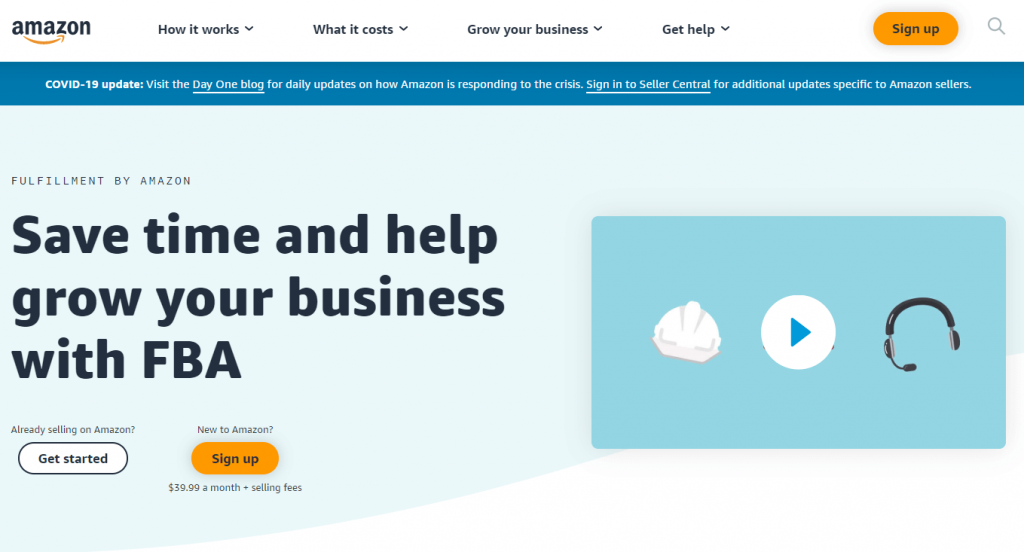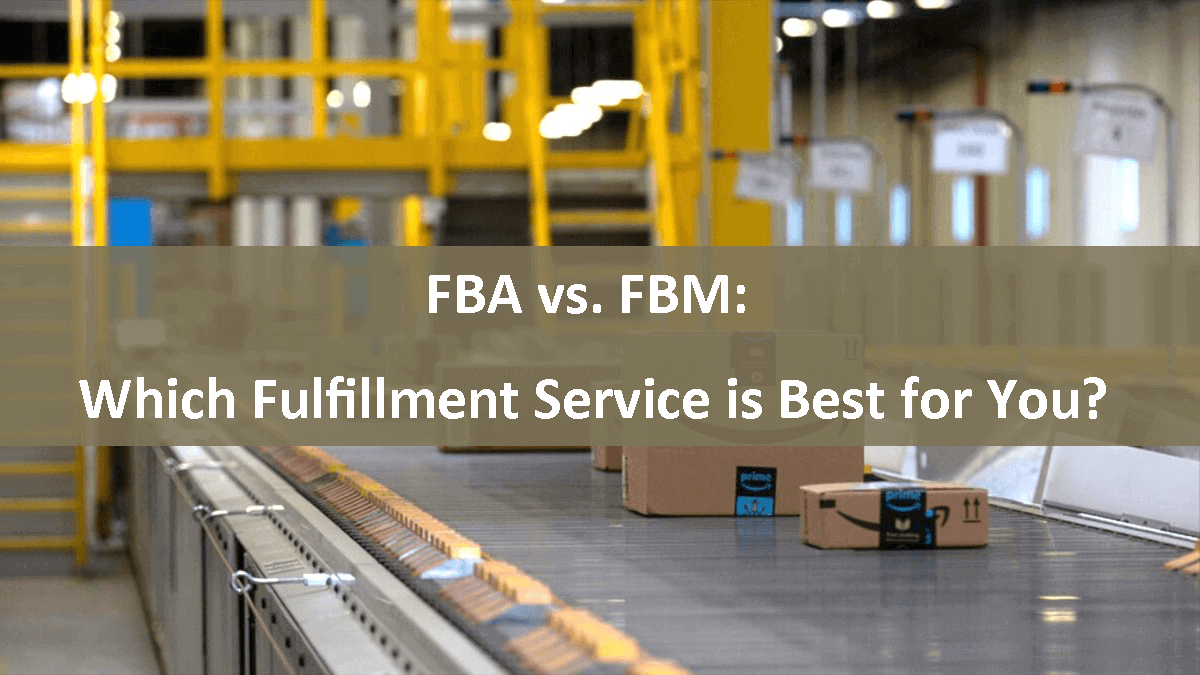If you’re someone looking to start selling on Amazon, you might be confused about which Amazon services are best for you.
You probably know that the two best services Amazon offers for sellers are Amazon FBA and Amazon FBM.
But which one of these should you choose? Who wins when it’s Amazon FBA vs. FBM?
Don’t worry; I’ve put together a detailed post covering everything you need to know about both these plans to make an informed choice.
Let’s get into it!
What is FBA?

Amazon FBA stands for “Fulfilled by Amazon.”
When you avail of the FBA service, Amazon takes your products, keeps them in one of its warehouses, ships it to people who want to buy, look at any refunds and manages all the logistical details related to shipping your products.
Amazon gives you a shipping deal where you, as a third party vendor, have the option of storing your products in Amazon’s fulfillment centers, and letting Amazon run things from their end.
By the end of this guide, we guarantee that your knowledge of FBA will be as clear as crystal can be.
Amazon FBA Features
Here, I’m going to list some of the prominent features that give Amazon FBA its shine and sparkle.
- Simple logistics
When you use FBA, you’re outsourcing the entire packing, storing, and shipping process to Amazon.
- Lower shipping rates
FBA gives sellers discounted shipping rates as they send their products to Amazon. This is a win-win because sellers benefit in the form of many orders on Amazon now being shipping-free.
- Customer service and returns
With Amazon FBA, you no longer have to worry about responding to customer queries and complaints yourself. Also, you’re no longer burdened by the difficult task of dealing with returned products, replacements, and reverse logistics.
- Huge storage capacity
As the volume of your orders starts growing, you may find it increasingly difficult and expensive to store and properly maintain a huge number of products yourself. Once you hand them over to Amazon, you can forget about your storage worries!
How Much Does FBA Cost?
Are you concerned about the various costs involved with Amazon FBA? We’ve got you covered. Here’s a full list of all the expenses you should know.
Amazon FBA costs usually include a monthly fee (if you’re a professional seller), product costs, shipping costs, and monthly fulfillment and storage fees.
Here’s a quick breakdown:
Fulfillment fees: These costs depend on the size, shape, volume, and weight of your product and can vary from $2.41 per unit to $137.32. These include the costs to pack items, store them, ship them, and deal with returns and customer service.
Labeling: If you’re not following Amazon’s label specifications for all products you send to them, you can incur a fee of 20 cents a unit
Stock removal fee: If you want to remove your products from amazon stocks, it will usually cost you 50-60 cents for every unit.
Long-term storage fees: If you store items at an Amazon Fulfillment Center for more than 35 days, you are subject to these fees.
FBA prep and unplanned prep service: Amazon has strict packaging requirements for FBA products. You can either pay Amazon to package your products or do it yourself. However, if you don’t meet their guidelines, you will be charged a fee for unplanned prep that usually varies from $1.00 to $2.2 per product unit.
Storage fees: Depending on what your products are, or even what time of the year it is, these costs can go from 48 cents per cubic foot to $2.40 per cubic foot.
How Does FBA Work?
Now it’s time to look at the specifics of how FBA works. Sit back, relax, and let us guide you the entire way.
1. Send Units to Amazon
This is where you get started,
Firstly, when you choose the FBA service, Amazon contacts you and asks what products you’re sending them.
You go to your Seller Central Account page and get your product listings ready.
Then you tell Amazon which ones it should handle the shipping for. You then make a shipping plan, where you give Amazon some important details.
2. Amazon Stores & Sorts Your Products in Warehouses
As soon as Amazon gets your products, they add them to their inventory. That means your products are officially listed in Amazon’s stock and are ready to be sold.
3. You Make a Sale
Time for the fun part!
At some point along the way, a customer decides to buy your product. Here, the FBA agreement ensures that Amazon handles the entire process for you.
So, Amazon makes the transaction, collects your money, ships your product, and changes your inventory based on the purchase.
4. Amazon FBA Takes Care of Customer Service
Are you worried about customer service? Stop right there, because Amazon won’t let you be.
Amazon prides itself on its amazing customer service. FBA means that instead of you having to follow up with customers yourself, and having to risk being bogged down by complaints, and details about the shipping, you can simply let Amazon handle it.
5. Earn Revenue
When it comes to your payment, Amazon deposits it directly into your bank account.
Amazon FBA Pros and Cons
- Automatic qualification for Amazon Prime.
- Hassle-free logistics and shipping.
- Utilize Amazon’s vast storage space.
- It ensures quick delivery and feedback management.
- It helps to win Amazon Buy Box and more sales
- Keeping track of the stock in your inventory can be occasionally troublesome.
- Shipping to Amazon can get complicated.
- A very easy return policy may mean that you get too many unnecessary returns.
What is FBM?
Amazon FBM (Fulfilled by Merchant) is Amazon’s plan to give the seller total control of the entire storage and shipping process.
Sellers are responsible for delivering their products to each buyer. As you may have guessed, this process may not be as alluring for many small-scale sellers who find storage and shipping difficult.
Amazon FBM Features
Amazon FBM is often overlooked because of the multiple benefits that FBA brings to a vast demographic of sellers, but that doesn’t mean that it won’t be a good fit for you!
Here’s a list of the most prominent FBM features you should be aware of.
- Less paperwork as compared to Amazon FBA
Amazon FBA has a lot of different costs for a lot of different things. The agreement involves a considerable amount of paperwork, which can be quite a hassle for new sellers. FBM relieves you of that extra burden.
- More freedom
If you’re someone who prefers knowing their business inside and out, Amazon FBM is the right fit for you.
- Greater profit margin
Since you don’t have to pay extra fees for shipping your products to Amazon, storing them, and maintaining them, you likely begin to see greater profit margins per product when using Amazon FBM.
How Much Does FBM Cost?
Time for some good news! As you may already know, Amazon FBM costs are nothing but the costs you incur while storing your items yourself and shipping them to customers yourself.
Here are the total fees you are subject to in an Amazon FBM agreement.
A monthly subscription fee: This costs nothing for an individual seller and about $39.99 a month for a professional seller.
Referral fee: Amazon charges you a specific amount every time a product of yours is sold on the platform.
Item fee: If you’re subscribed to the professional plan, you don’t incur an item fee. However, if you’re an individual seller, you are usually charged $0.99 per item sold.
How Does FBM Work?
Amazon FBM is extremely simple to figure out. Instead of the somewhat complicated processes, you need to go through to set up an Amazon FBA agreement; an FBM strategy only requires you to become a seller on Amazon, nothing else.
If you’re an individual or a professional seller on Amazon who stores their stock themselves and ships to customers independently, you already fall under the banner of Amazon FBM! Simple, right?
Amazon FBM Pros and Cons
- More independence over your inventory.
- Better opportunity to build a brand name for yourself.
- Less paperwork than FBA.
- You can control your shipping and fees
- You have to take care of storage and shipping yourself.
- Finding good deals and reliable service carriers can be difficult.
- It can be a hassle to look after your logistics while trying to manage your product listings.
- It can be hard to fight for Amazon Buy Box if ships with FBM channel
FBA vs. FBM: What Are Their Differences?
As it pertains to Amazon FBA and FBM, the debate about which is better drags on.
It mostly depends on what your priorities are as a seller and what time of business model works better for you.
Let’s look at many ways Amazon FBA and FBM differ from each other. Hopefully, this section will give you a better understanding of the key details that underlie each selling method.
- 1. This selling method outsources your storage, inventory management, and shipping to Amazon. All you have to worry about is managing your product listings on Amazon.
- 2. Amazon takes care of item returns and customer feedback.
- 3. You incur costs for using Amazon’s warehouses as storage space and for having Amazon manage shipping without you having to get involved.
- 4. This fulfillment method is a lot more hassle-free. You can rest easy when it comes to managing shipping and reverse logistics.
- 1. Amazon FBM users take care of shipping, storage, and returns on their own, without getting Amazon involved.
- 2. Sellers have to manage returns and customer feedback by themselves.
- 3. You don’t incur any extra costs from Amazon other than the usual seller and item fees.
- 4. This method allows you a lot more “hands-on” selling experience where you look after your inventory yourself, ship your products yourself, and are personally responsible for returns and reverse logistics.
What Should a Seller Consider When Choosing Fulfillment Services?
There are several details you need to sort out before you pick a fulfillment service. Worried? Don’t be! We’re here for you.
Firstly, how much storage space do you need for your products? If you need large storage space in a convenient setting, go for Amazon FBA.
If you don’t, we recommend that you opt for FBM and save your money.
Secondly, look at where you can cut costs in the shipping process. If shipping independently costs you less than employing Amazon FBA, go for FBM!
Otherwise, you should depend on Amazon’s reliable shipping services.
Lastly, what kind of business do you want to run? Do you want a more “personal” experience where you can micro-manage a lot of stuff? Go for FBM! If not, FBA is your best shot at successful selling.
Which Option is Best for You?

Should you pick Amazon FBA or FBM? Which is better for you? Well, keep reading and find out.
To find out the answers to the questions, you should fully consider it based on your own experience and financial strength.
If you are an experienced seller on Amazon, have ample supported with funds, or know how to find the most profitable products, then you can start directly from FBA.
The advantage of FBA is its high weight which will help with product rankings. Of course, it also has obvious disadvantages.
That is, it takes up too many funds and inventory. Once the product is unsalable, it will affect your capital chain.
Therefore, if you want to sell on Amazon with FBA, you must be careful about product researches. Otherwise, every penny you invest in the products may be in vain.
With FBM, it will not take up too much of your capitals and inventory so you can freely decide what to sell and how many inventories you keep.
However, you don’t get to win the Amazon Buy Box and your product rankings will be lower and lower. If your product happens to be the most competitive ones, you will find that even if you launched thousands of listings, there is not even one sale.
So, to sum up, if you have confidence in your products and have enough fund supports, you can go for FBA.
If you are just a new seller and have no idea of your profitable products, FBM is a great way to help you get started and gain more experience.
For Small start-ups
Around 63% of all sellers on Amazon use FBA with remarkable results.
Most of these sellers are small business owners or start-ups looking towards Amazon FBA as a crutch to lean on for support.
For Large corporations
Amazon FBM can be a great option for large businesses with multiple warehouses spread across a country.
It is often more profitable for such businesses to rely on their resources than to spend extra money on Amazon’s services.
Amazon FBA alternatives
If you’re not a fan of FBA, there are several alternative logistic providers you can choose to partner with.
Here’s a list of some of the top alternatives to Amazon FBA.
We recommend that you take your time, compare the profiles of all these major brands, and pick one that best fits your needs.
Conclusion
There you have it! A complete guide on the Amazon FBA vs. FBM debate.
We listed the unique features, costs, pros, and cons of each fulfillment model as best as we could. We hope this guide helped you in choosing the right service for you.
We’d love to address any further concerns you have, so don’t be shy about reaching out to us!
Recommended Readings:
How To Ship Product To Amazon FBA Warehouse
Amazon Long Term Storage Fees: 5 Tips FBA Sellers Should Never Miss
Your Newest Guide to Amazon FBA Fees in 2020
A Complete Guide to Choosing an Amazon Freight Forwarder
11 Amazon FBA Inspection & FBA Prep Services Companies Sellers Should Know About

Leave a Reply
You must be logged in to post a comment.